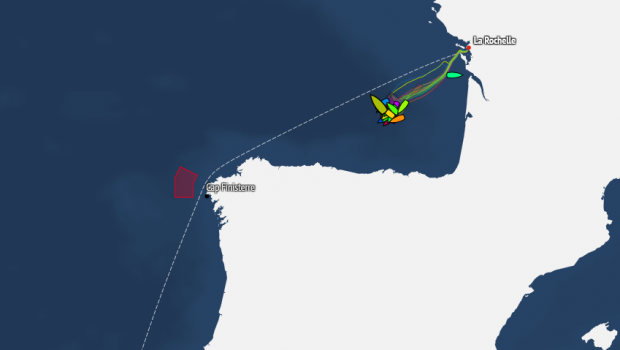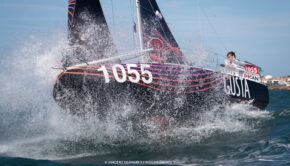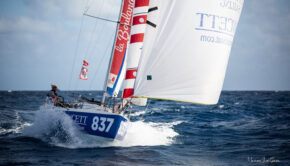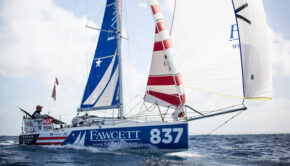Mini Transat: Finding the rhythm
Published on October 2nd, 2017
(October 2, 2017; Day 2) – The first 24 hours of a race like the Mini-Transat are a funny old time. Whatever we say and whatever we do, it takes time to adapt before you can power along at your full potential and really enjoy being at sea. This is particularly true when the weather’s not really on your side: grey skies, rough seas, upwind sailing. The tough times will give way to better days in the fullness of time of course.
The first 24 hours are now in the wake for the 81 starters. For all that, the switch from one world to another hasn’t gone without its share of difficulties as a result of minor preparation issues and the time required for the solo sailors to get into the swing of things.
Seasick but not sick of the sea
Enemy number one for some at the moment is sea sickness. At this morning’s audio session, certain sailors admitted feeling a little under the weather, including Julien Bozzolo (Mariolle.fr), François Denis (So-Boat.com) and Arnaud Etchandy (Ipar Hego). They’re surely not alone in this, but at the front of the fleet the leaders are already being careful not to disclose any signs of weakness as tradition dictates.
Technical glitches
The first hours of racing can also have their share of nasty surprises. Contrary to professional skippers, a Mini sailor rarely has a dedicated ‘préparateur’ or shore crew. Indeed, when it’s not the racer himself or herself, friends often step in to make sure the boat is ready to go within the time limit.
In these conditions, it’s hard to be totally shipshape and some sailors are lamenting minor issues which, though not dramatic, can make life awkward in these initial hours of racing. In this way, Julien Héreu (Poema Insurance) has been trying to resolve an issue with his generator, whilst Marc Miro (Alfin) has reported difficulties getting his AIS to work.
Meantime, Irish skipper Thomas Dolan (Offshoresailing.fr) has had to retrace his steps after realising that he’d failed to respect the course marks at the coastal course gate. Italian Matteo Rusticali (Spot), who set sail at the helm of the oldest boat in the race, built for the Mini-Transat 1991, has sadly dismasted and was originally making for La Rochelle under jury rig. Given his course, it would seem that he’s now opted instead for the mouth of the Gironde estuary to make landfall.
Strategic headache ahead
For now, the remainder of the fleet is trying to contend with a system of prevailing westerlies. All in all, everyone had opted to sail on starboard tack taking them towards Cape Ortegal. With the wind kicking back in from the west, the first choices will have to made: continue along on the same tack or make headway to the north?
The weather forecasts are announcing the arrival of a front via the north-west, which should generate some north-easterly wind off its back. By continuing on their tack, the sailors may be in with a chance of closing on the tip of Spain and reaping the benefits of a wind that will ultimately provide everyone with downwind conditions.
By making headway to the north, it should be possible to anticipate the arrival of the front to ensure they’re first to benefit from the wind shift. At the head of the fleet, the skippers appear to have opted for the second solution, with the exception of Romain Bolzinger (Spicee.com)).
Leading the march, Erwan le Mené (Rousseau Clôtures) once more has the edge over Ian Lipinski (Griffon.fr) but there is little separating them. Behind the leaders, three sailors are managing to keep pace: Aurélien Poisson (TeamWork), who has really been on his game since the start of the race, Jorg Riechers (Lilienthal) and Charlotte Méry (Optigestion – Femmes de Bretagne).
Among the production boats, a number of competitors thought Rémi Aubrun (Alternative Sailing – Constructions du Belon) would be the one to beat, even though he’s done little racing this season. A quick look at the cartography would suggest they were right to be wary as he’s keeping a firm hand on Erwan Le Draoulec (Emile Henry), the latter just two tenths of a mile in front. Valentin Gauthier (Shaman – Banque du Léman) completes the current podium.
Also worth noting is the fine performance posted by the Czech sailor, Pavel Roubal (Pogo Dancer), who is just two miles shy of the leaders, despite some complicated training conditions for this sailor, who divides his time between his life in Brno and the Med. Prior to the Mini-Transat, Pavel took a break from sailing to recharge his batteries and spend the summer with his partner and his daughters. His method seems to be paying off…
Ranking at 15:00 UTC
Prototypes
– 1 Erwan le Mené – Rousseau Clôtures – some 1,203.2 miles from the finish
– 2 Ian Lipinski – Griffon.fr – 1.1 miles behind the leader
– 3 Romain Bolzinger – Spicce.com – 2.2 miles behind the leader
– 4 Aurélien Poisson – TeamWork – 2.7 miles behind the leader
– 5 Jörg Riechers – Lilienthal – 3.7 miles behind the leader
Production boats
– 1 Erwan Le Draoulec – Emile Henry – some 1,208.9 miles from the finish
– 2 Rémi Aubrun – Alternative Sailing – Constructions du Belon – 0.2 miles behind the leader
– 3 Valentin Gauthier – Shaman – Banque du Léman – 0.9 miles behind the leader
– 4 Pierre Chedeville – Blue Orange Games – Fair Retail – 1.5 miles behind the leader
– 5 Clarisse Crémer – TBS – 1.8 miles behind the leader
Class news – Race news – Tracking – Facebook
Race Facts
· Sunday 1 October: Start of the Mini-Transat La Boulangère in La Rochelle, France
· 21st edition
· 4,050 miles to cover between La Rochelle – Las Palmas in Gran Canaria and Le Marin (Martinique)
· 81 skippers at the start
· 10 women
· 11 nationalities
· 20 years: age of the youngest skipper in the race: Erwan Le Draoulec
· 62 years: age of the oldest skipper in the race: Fred Guérin
· 25 prototypes
· 56 production boats
· 66 rookies
· 15 ‘repeat offenders’
Background
With an overall length of 6.50m and a sail area pushed to the extreme at times, the Mini Class offers incredibly seaworthy boats. Subjected to rather draconian righting tests and equipped with reserve buoyancy making them unsinkable, the boats are capable of posting amazing performances in downwind conditions… most often to the detriment of comfort, which is rudimentary to say the least.
The Mini Transat has two legs to carry the fleet from La Rochelle, France to Martinique, West Indies. The leg from La Rochelle to Las Palmas de Gran Canaria is a perfect introduction to proceedings before taking the big transatlantic leap.
The first leg starts on October 1, with the fleet thrust into the Bay of Biscay which can be tricky to negotiate in autumn, while the dreaded rounding of Cape Finisterre on the north-west tip of Spain marks a kind of prequel to the descent along the coast of Portugal. Statistically, this section involves downwind conditions, often coloured by strong winds and heavy seas. Making landfall in the Canaries requires finesse and highly developed strategic know-how.
The second leg begins on November 1, with the solo sailors most often carried along by the trade wind in what tends to be a little over two weeks at sea on average. At this point, there’s no way out: en route to the West Indies, there are no ports of call. The sailors have to rely entirely upon themselves to make Martinique.
Source: Aurélie BARGAT | Effets Mer









 We’ll keep your information safe.
We’ll keep your information safe.